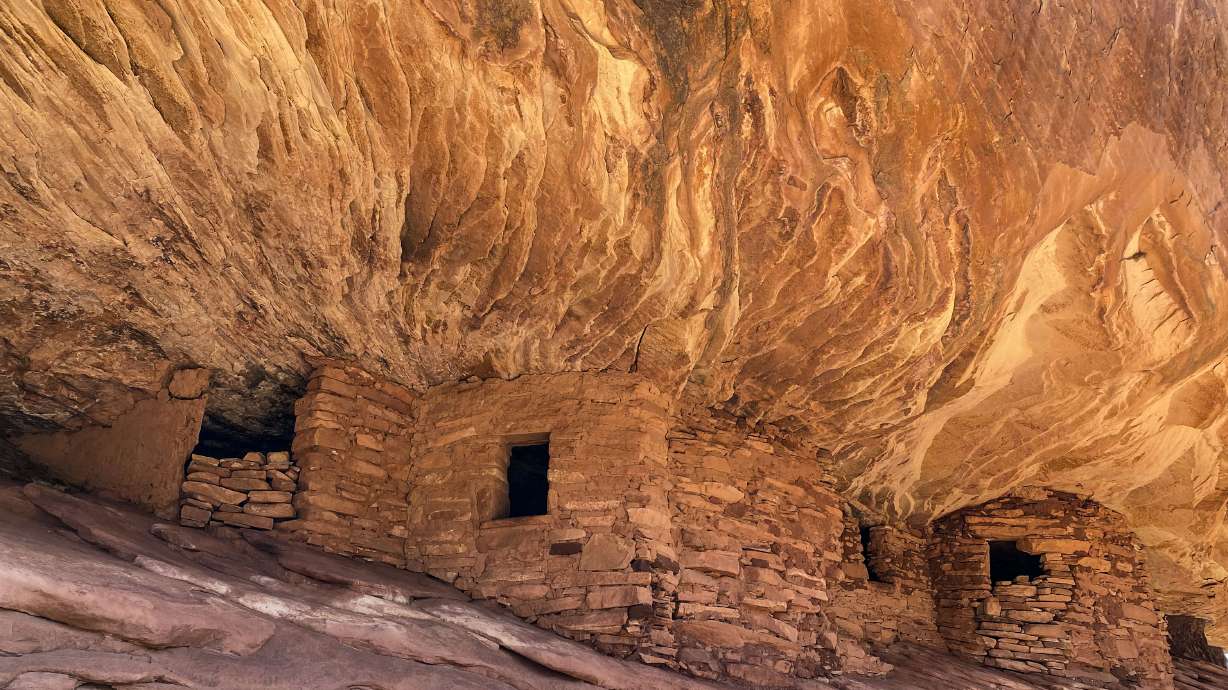Estimated read time: 4-5 minutes
This archived news story is available only for your personal, non-commercial use. Information in the story may be outdated or superseded by additional information. Reading or replaying the story in its archived form does not constitute a republication of the story.
- Federal agencies have released a final plan for managing the 1.36-million-acre Bears Ears National Monument.
- The plan incorporates tribal heritage with inputs from tribes, stakeholders and the public, emphasizing co-stewardship with tribal nations.
- Key provisions include maintaining 88% of the land for livestock grazing, prohibiting recreational shooting, allowing hunting and restricting motorized events in sensitive areas like Arch Canyon.
SALT LAKE CITY — Federal agencies on Thursday released a final environmental impact statement and proposed plan outlining the management and protection of the 1.36-million-acre Bears Ears National Monument.
The plan, if approved, would "ensure lasting protections for the monument's cultural and natural resources, including ancestral cliff dwellings and culturally significant landscapes, while providing continued opportunities for outdoor recreation such as hiking, camping and hunting," said a release from the U.S. Bureau of Land Management.
Tribal input, and feedback from cooperators and stakeholders, as well as the public, is included, informed by the "best available science, including Indigenous knowledge, to ensure balanced use and protection of important resources."
"Bears Ears is integral to our ceremonies, traditions, and identity as tribal peoples. Co-stewarding this sacred landscape with our agency counterparts ensures we can continue passing down our cultures and lifeways," the Bears Ears Commission said in a statement. "We hope the invitation to return to our ancestral homelands as collaborative managers will commence a much-needed collective healing process. This proposed resource management plan represents the tribes' deep engagement with and commitment to, the first national monument established at the request of five Tribal Nations and the first to formally adopt traditional Indigenous knowledge as a guiding principle in the enduring management framework for the monument."
Here are some of the major takeaways from the plan.
Grazing
Under the proposed plan, 88% of the public land within Bears Ears would be available for livestock grazing, a 2% decrease from the existing grazing allotment.
This represents a 27,210-acre decrease in areas available for livestock grazing on BLM land. However, there were no changes to areas deemed suitable for grazing on U.S. Forest Service land.
Recreational shooting
The proposed plan aims to prohibit any recreational shooting in the monument, though, there are popular recreational shooting alternatives outside the monument.
Hunting within the monument would still be allowed, following the regulations of the Utah Division of Wildlife Resources.
Off-highway vehicles
Over 1,000 miles of currently designated roads would remain open to off-highway vehicle use. The plan stipulates that a system of roads in a 726,000-acre area will be used to protect monument objects, provide access and reduce conflict on BLM land.
Additionally, Arch Canyon would remain accessible for both motorized and nonmotorized use, with permits required for all uses. "Motorized events," however, would not be allowed in Arch Canyon.
Moon House
Moon House is one of the most popular archeological structures in Bears Ears and a common hiking route and under the proposed plan, it would still be accessible via permit, but the inside courtyard would be closed to visitation.
"Archaeological sites like this one are sensitive to disturbance and inherently fragile. Closing the inner courtyard would protect the integrity of the site for this and future generations," the agencies said.
Plan process
The BLM and Forest Service kicked off the public comment period for the draft resource management plan in March and held seven public meetings. Across these meetings, the agencies heard nearly 19,000 public comments.
"Through collaboration and coordination with the Forest Service, Bears Ears Commission, Tribal Nations, partners, local communities, stakeholders and the public, we have proposed great steps to protect and preserve Bears Ears National Monument," BLM Utah State Director Greg Sheehan said in a statement. "The proposed plan would ensure that opportunities for recreation, livestock grazing and other appropriate and compatible uses continue well into the future."
A release from the agencies said they worked closely with the five tribes of the Bears Ears Commission, including the Hopi Tribe, Navajo Nation, Ute Mountain Ute Tribe, Ute Indian Tribe of the Uintah and Ouray Reservation and the Pueblo of Zuni — whose ancestral lands are within Bears Ears.
In addition to protecting cultural resources, the agencies say the proposed plan will maintain existing uses of the land, including cattle grazing, recreation and traditional gathering of firewood and plants.
"The plan recognizes the monument's role as a place of recreation for hikers, backpackers, climbers and rafters and as a place of solace and respite for visitors," the agencies said.
On Friday, a notice of availability will be published in the Federal Register, starting a 30-day protest period and 60-day governor's consistency review. The protest period will end Nov. 4. Following this, the BLM will issue a record of decision and approved resource management plan and the Forest Service will issue a record of decision amending the 1986 Manti-La Sal National Forest Land and Resource Management Plan.
Anyone can file a protest electronically online here.
"The Bureau of Land Management and our many partners have provided essential insights in determining the management direction for Bears Ears National Monument," Forest Supervisor of the Manti-La Sal National Forest Barbara Van Alstine said in a statement. "These efforts will serve current and future generations who access Bears Ears in all its diverse uses."
The full proposal and environmental impact statement can be found here.









